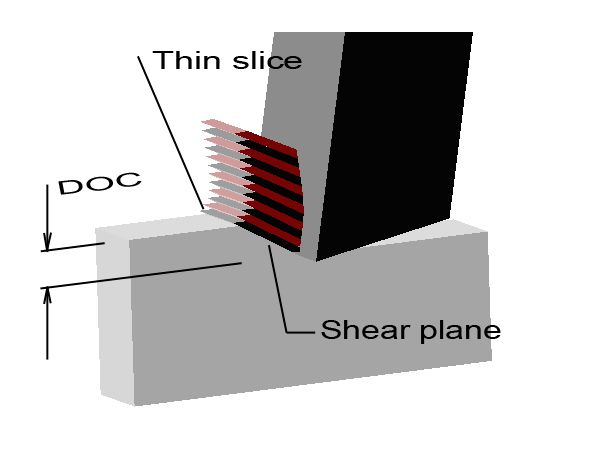Hi Norman,
Although I have stood for many hours watching swarf in many forms as it leaves various machine-tools, and can remember a little about Mohr’s Circle as applied to metal cutting theory, I cannot venture too far down this burrow. It is unfortunate however, in the context of metals, that we use the word `cut’.
I say this because the action is more complex.
For simplicity, I’m basing my comments upon the action as seen during the surfacing of a round bar of metal in a lathe.
The way I understand it, (and I have a simple way to demonstrate it), the so called `cutting’ action commences when the tip of the tool-bit first bites into the metal and causes the material of the workpiece to momentarily fail in compression. Almost immediately, as the stress level builds up, the material ahead of this compressed portion fails in shear. The failure takes place at a specific angle referred to as the shear plane.
Almost immediately, this shearing action stops, and the compression process begins again. The stop-start process is repeated at a rapid rate as can be seen by examining the `inside’ and `outside’ faces of the swarf.
Let it cool first!!! 
It is usual to see a form of rough `shuttering’ or shark-skin on the inside face of the swarf, while the outside face appears `polished’. This polishing is a result of the material being compressed and then burnished as it slides over the top face of the tool-bit. The shuttering is evidence of the stop-start failure pattern.
The shear plane varies from metal to metal, and will also be influenced by the angle of the top rake. Beyond this, and in terms of the energy dissipated, etc., I am out of my depth.
I can however, invite you to explore the action using a fresh tub of margarine from the fridge, and a normal table knife. Between meals and with the permission of SWAMBO, the kitchen is a wonderful place to investigate.
For this test, the knife does not have to be sharp. Taking hold of the knife as if you were about to `butter’ a slice of bread, tilt the blade at right-angles to the surface of the margarine. Starting from one side and with the blade pressed into the margarine a few millimetres, sweep the blade across the surface is if it were a planing tool.
Given that you have got the angle about right, you should see (stuck to the knife) an enlarged version of a piece of metal swarf.
If, for any reason, especially if SWAMBO is hovering around, and you need a bit more detail, I’ll shall be quite happy to take a photograph or two and plonk them into the thread.
Good luck!
Sam
Edited By Sam Stones on 21/04/2011 04:59:40
Edited By Sam Stones on 21/04/2011 05:01:14
John Olsen.






 I don’t have a fresh tub of margarine to demonstrate the action of how metals actually `cut’. Instead, I’ve cobbled up a simple diagram to show what I remember of the so called `cutting’ action.
I don’t have a fresh tub of margarine to demonstrate the action of how metals actually `cut’. Instead, I’ve cobbled up a simple diagram to show what I remember of the so called `cutting’ action.



